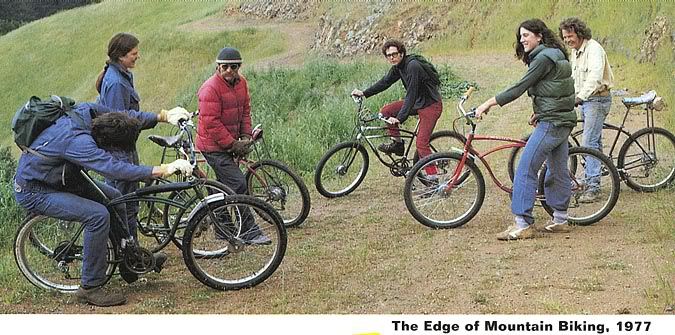Rockin' those bull moose handlebars....80's style.
 |
| I rarely take self portraits, but this one seems very period correct, Star Wars tee shirt and all. |
My first impression of this bike is how indestructible it feels while riding. This bike comes with really beefy Araya 26x1.75 alloy wheels with high flange sealed hubs that are bolted onto the frame. The wheels alone probably have a combined weight of over 10 pounds, including the tires and tubes. Although this was a bit of a drawback while climbing, I feel that these wheels can rollover and mow down anything in their path. I don't think there is anything that I can do to easily taco these rims.
This bicycle features the highly coveted bull moose handlebars. Bull moose handlebars have a unique design that combines the stem and handlebars into a single welded piece. Adding to the uniqueness of this design, this bike comes with old school friction thumb shifters as well.
 |
| "Bull Moose" handlebars and thumb shifters, also known as "thumbies". |
 |
| Dia Compe cantilever brakes were one of the first braking systems used on mountain bikes. |
When I got this bike, it was covered in silt over years of not being cleaned or maintained. The grease was 30 years old and never changed out throughout it's existence. I took this bike apart, regreased all the bearings and dunked most of the drivetrain parts in Simple Green to get the years of dirt and grime buildup off of them. I re-lubricated the chain as a temporary solution but will end up replacing the chain and freewheel in the future to make it ride just a little smoother.
So, how does it ride? Let me start off by saying that this bike isn't for everyone. Its an old bike, there should be no illusions of it riding like a modern mountain bike or better. For one thing, climbing hills on this bike is more difficult because of the bigger front chainrings, the longer wheelbase and the overall weight of this steel bike. I made all of the hills I normally make on this bike, but found myself climbing on my largest rear sprocket most of the time. Granted, I had a backpack full of my camera gear when I took these photos on my last ride. What this bike lacks going uphill it makes up for on the way back down. This bike rides like a beast on flat singletrack and takes downhills with speed. Its important to keep in mind that people were not thinking of riding their bikes over rock gardens or getting massive air off of jumps when these bikes were made. In the early years of mountain biking there was a big focus on trekking rather than racing like there is nowadays. Having a durable bike that could take a beating was key, but people also had the common sense to get off their bikes when the terrain became too gnarly. The mountain bike was originally designed to take people where a road bike couldn't go. In it's humble beginnings, it was purposed as a tool for exploration rather than an off road racing machine. Although this bike is heavy, there is no compromise to it's durability and this mountain bike rides like a tank. These are how the first mountain bikes that rolled off the assembly line were built.
This bike marks the start of a new focus for my blog, as well as a shift in the type of bikes that I will be collecting, riding on and talking about. I'll still do a couple of articles on vintage road bike riding, however the preservation of old-school mountain biking culture has taken precedent. One might assume that I'll be going off on a tangent of all things 90's mountain bike related, like talking about John Tomac's drop bar riding position or Tinker Juarez. Not at all; I'll be talking about mountain bike culture from the way I grew up seeing it, not from a nostalgic ex-racer's point of view. Some very interesting articles to come. Stay tuned!








